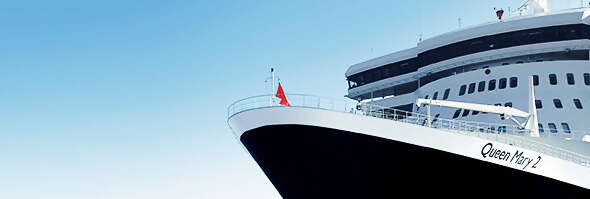OCEAN TRAVEL Obstacles and opportunities
Posted on 08/05/2016

I’ve travelled on big ships, small ships and tall ships. I’ve also done self-skippered cruising in England, Ireland and France. Whenever an assignment takes me to sea, friends push for an invitation to join me. The world, I have learned, loves water. So it was a surprise when I couldn’t convince any of these wannabe cruisers to join me on a transatlantic crossing from Southampton to New York on the Queen Mary 2.
This was the final portion of a three-and-a-half week cluster of assignments. After checking in and out of 14 hotels in a 17-day period, it was a treat to sleep in the same bed, not sacrifice part of my day to a continuous check-in-and-out process or have to drag my bags anywhere. I had so much luggage I hurt myself.
At a welcoming reception the ship’s master, Captain Kevin Oprey strongly made the point that this is a voyage, not a cruise because the Queen Mary 2, like her sister ships - the Queen Victoria and Queen Elizabeth – is an ocean liner. They are unique in that their hulls are specifically designed for transoceanic travel.
Cunard generously extended an invitation for a travelling companion to join me for the voyage. You would think people would jump at the chance for such a luxurious adventure. I was surprised that three long-time friends, who have expressed a desire to cruise, each turned down the opportunity. I was assured it wasn’t personal.
Their universal resistance was the fear of boredom. With no ports of call, what would they do for a week at sea? That concerned me as well, but this was work, so my days were filled.
Obviously, Cunard has had this concern expressed before. The voyage was something akin to an Edwardian house party without hunting or dotty dowagers asking, “What’s a weekend?” There was dressing for dinner. I like that Cunard didn’t present this as a stuffy rule, but positioned it as a way of showing respect to your fellow passengers.
As for boredom, I didn’t have time. Between the ship’s physical amenities, services and social programming, days and nights are as full as you wish. The lecturers and speakers ranged from author Margaret Atwood, to an expert who gave fascinating talks on New York architecture and skyscrapers, an astrologer and a woman who literally ran around the world.
Live entertainment comprised students of the Royal Academy of Dramatic Arts, concerts by a classical guitarist, pianist and French chanteuse, plus shows by the ship’s performers as well as two jazz bands, two orchestras and a DJ in the disco. These were augmented by a full array of classes and sporting activities. There is the gym, the pools, spa, a measured walking and jogging course, in-room TV, movie nights, a 10,000-volume library and satellite Wi-Fi that’s faster than many land-based properties I’ve stayed at.
My hesitant friends were also concerned about how rough an October crossing would be. It was an astonishingly calm crossing. One morning I woke to a gentle swaying, as if in a hammock. My king balcony cabin was near the stern. At the front you noticed the waves more, but still they weren’t more than 10 feet/three metres high, which might be an issue for another type of ship, but not the unique hull design of Cunard’s. In truth, the kid in me was sorry this was such a short experience. It didn’t last to lunch.
Even though I had the fast Wi-Fi connection, being at sea was a glorious excuse to exclude the world’s distractions and take time to stare into the infinity of sea and sky. It was only on day six, when we reached the Grand Banks that we saw other ships on the horizon. For additional entertainment, a row of whales stretched across several miles of sea, spurting water into the sky like some comic Disney-like organ. It was also so warm that I nodded off in one of those famous, teak deckchairs.
Via ship-board friendships I learned that a number of repeat passengers use trans-oceanic voyages as their preferred means of travel between continents. Thanks to a New Yorker, who was on his 58th crossing and recognized many faces, we estimated at least 40 passengers were regulars. These are people who determined that for the price of a last-minute full-fare or business class seat, they can have a comfortable seven days at sea vs seven hours in the air, with the additional bonus of arriving at their destination without jet-lag.
These travellers mirrored a previous experience I had on Swan Hellenic’s Minerva. Minerva’s Islands of the Sun cruise had an exalted passenger manifest that included several peers, seven ladies, six knights, three ambassadors and the admiral who won the Falklands War. While people with options in life, many I spoke with said Minerva’s use of Portsmouth for departures and arrivals meant they could travel by land and eliminate what they considered the horror and indignity of airports and airlines.
Thinking about a brokerage house VP I knew who so hated flying that he took an extra two days to travel by train from Halifax for meetings in Toronto and New York, I wondered if this isn’t a way to market coastal cruises. For example, skittish fliers could be sold on the New England-Atlantic Canada route because, in addition to the itinerary, departure and arrival ports – Montreal, Quebec City, Boston and New York – are shorter flights and/or accessed by rail service. Perhaps there’s room for a rail-and-sail package?
So much of travel is focused on rush and speed that we can overlook the luxury of lingering. Ocean travel provides it. As one man told me, “It’s my retirement gift to myself.”
My friends lost out on a great experience.




